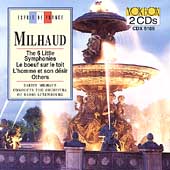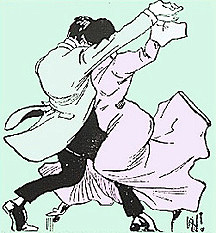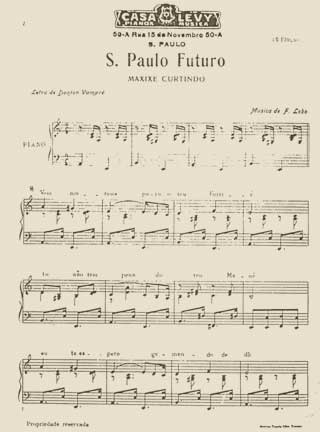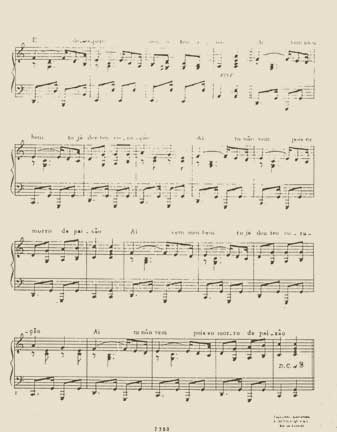The Boeuf chronicles, Pt. 1
How the ox got on the roof:
6 April 2002
Darius Milhaud and the
Brazilian sources of
Le Boeuf sur le Toit.
In 1992, the Brazilian composer Osvaldo Lacerda published an article in the Revista da Sociedade Brasileira de Música Contemporânea. Titled “Três amigos da música brasileira,” the article was devoted to three foreign composers—Louis Moreau Gottschalk, Darius Milhaud, and Ottorino Respighi—who “wrote works that may be considered part of our cultural patrimony.”
The chapter on Milhaud focuses on Saudades do Brazil, whose melodies Lacerda characterizes as being more “Milhaud” than “Brazil.” Toward the end, the author adds:
Outra composição “brasileira” de Darius Milhaud é o bailado orquestral “Le boeuf sur le toit” (“O boi no telhado”), op. 58, datado de 1920. Consiste ele numa série alegre e entusiástica de maxixes e tangos brasileiros. Neste caso, porém, as melodias provêm da música popular brasileira da época em que Milhaud residiu no Brasil, entremeadas de um insistente refrão que, segundo dizem, é da autoria do próprio Milhaud. Para analisar-se “Le boeuf”, seria necessário ter-se em mão a partitura, mais alguém que tivesse condições de identificar todas as inúmeras melodias da obra. Pergunta-se, então: – ainda estará vivo esse “alguém”?...
Another “Brazilian” composition by Darius Milhaud is the orchestral ballet “Le boeuf sur le toit” (“O boi no telhado”), op. 58, dated from 1920. It consists of a joyful and enthusiastic series of Brazilian maxixes and tangos. In this case, however, the melodies come from Brazilian popular music of the period in which Milhaud resided in Brasil, interspersed with an insistent refrain that, it is said, is of the authorship of Milhaud himself. In order to analyze “Le boeuf,” it would be necessary to have the score in hand, plus someone who would be able to identify all the countless melodies of the work. One wonders then: – is there still such a “someone” alive?...
In August 2000 I began an investigation into the Brazilian melodies quoted by Darius Milhaud—without identification or attribution—in his most famous composition, the rondo Le Boeuf sur le Toit (The Ox on the Roof, 1919). As all the tunes were necessarily old, the search has been long—in fact, it isn’t over yet.
Along the way I exchanged information with and benefited from the knowledge of many people, principal among them the musicologists Aloysio de Alencar Pinto and Manoel Aranha Corrêa do Lago (who published articles on the topic and presented me with invaluable research material); the journalist Anja-Rosa Thöming (who wrote a scholarly paper in German); the young pianist Alexandre Dias, listowner of the choro discussion group O Malho (who tirelessly searched for old recordings and created new ones of the unrecorded tunes); the record collector Roberto Lapiccirella, webmaster of the excellent site Ao Chiado Brasileiro (who provided a wealth of Marcelo Tupinambá recordings); and Anna Paes and Mauricio Carrilho (who presented me with copies of many old scores from their extensive archive).
This is the first in a series of vignettes, each highlighting a Brazilian tune quoted in Le Boeuf sur le Toit and following the same order in which the tunes appear in Milhaud’s rondo. The timings used to orient the listener correspond to those in the recording by the Orchestra of Radio Luxembourg under the baton of Louis de Froment (VoxBox CDX 5109), from which I extracted the Boeuf audio samples you’ll be hearing. In his 1949 autobiography Notes Without Music, Milhaud wrote:
Still haunted by the memories of Brazil, I assembled a few popular melodies, tangos, maxixes, sambas, and even a Portuguese fado, and transcribed them with a rondo-like theme recurring between each successive pair. I called this fantasia Le Boeuf sur le toit, which was the title of a Brazilian popular song.
The Viaduto do Chá in São Paulo connects Rua Barão de Itapetininga (formerly Rua do Chá) to Rua Direita. On the right is the Municipal TheatreTune No. 1: “São Paulo Futuro” (1914)
It is generally accepted by scholars that the recurring rondo-like theme is Milhaud’s creation. Listen to an excerpt.
The first Brazilian tune to be heard in Le Boeuf sur le Toit is the maxixe “São Paulo Futuro” by Marcelo Tupinambá (1914). Section A of the song begins seventeen seconds into the Froment recording, immediately followed by section B at 35 seconds.
Section A will be repeated toward the end of Le Boeuf sur le Toit, at 13:59 min.
As I mentioned in Doutor Tanguinho, “São Paulo Futuro” was introduced in an eponymous theatrical revue. In his book Marcelo Tupinambá, Obra Musical de Fernando Lobo (São Paulo, 1993), Benedicto Pires de Almeida reproduces a playbill of the Teatro São José, advertising the “Primeira representação da grande revista de costumes paulistas de Danton Vampré e J. Nemo, música do maestro F. Lobo” on Friday, 24 April 1914. On both the 24th and the 25th of April, O Estado de São Paulo published detailed articles about the production.
The song’s claim to fame is in being the first maxixe with lyrics to have been recorded in Brazil, although José Ramos Tinhorão informs us in his article “As Primeiras Gravações” that this claim is based on a mere technicality, and the title should belong to the earlier “O Forrobodó” by Chiquinha Gonzaga, disqualified owing to the subtitle Tango do Guarda Noturno on the disc label.
“Maxixe” by KalixtoMy favorite information source for 78-rpm recordings, The Funarte database at Fundação Joaquim Nabuco, lists the following early recordings:
Autor: Marcelo Tupinambá
Título: São Paulo Futuro (Os Cavalheiros do Luar)
Gênero: Serenata
Intérprete: Bahiano
Gravadora: Odeon
Número: 120.991[Tinhorão provides the disc number 120.986, which doesn’t appear in the database.]
Autor: Marcelo Tupinambá
Título: Maxixe Curtindo (São Paulo Futuro)
Gênero: Maxixe
Intérprete: Grupo Odeon
Gravadora: Odeon
Número: 120.995More recent recordings were made by Roberto Fioravante in the 1968 LP Mensagem de Saudade (Chantecler) and by Maricenne Costa in the 1999 CD Como Tem Passado!! (CPC-UMES CPC 026).
This audio sample includes Sections A and B, excerpted from Roberto Fioravante’s recording.
It is also available as a complete track.
São Paulo antigoThe piano score published by Casa Bevilacqua in 1915 as Musica para Dança included these lyrics:
S. Paulo Futuro
Maxixe Curtindo
Versos do Dr. A. A.
Musica de F. LoboVem cabocla na ponta dos pés
que uma coisa eu te quero dizer
Si malvada cabocla não és.
Não me deixe de sede morrer.Ai! quero sim.
Dos teus labios licór.
Ai! quero em fim
cahir bebado de amôr. [bis]Vem cabocla; ligeira a correr
mitigar das saudades a dôr!
Não me deixe de frio morrer
Que teus olhos tem vida e calor.Ai! quero em fim
do teu collo o fogareiro.
Ai! quero sim
quero ir quente para o céo. [bis]Below are the lyrics recorded by Roberto Fioravante and Maricenne Costa. The latter’s CD notes date them from 1917 and credit only Tupinambá:
Vem morena
pro teu furrié [furriel]
tu não tens pena
do teu Mané.
Eu te espero
gemendo de dô
e desespero sem o teu amôAi, vem meu bem,
tu já deu teu coração...
Ai, tu não vem,
pois eu morro de paixão. [bis]Vem marvada
este pranto secá
nas labaredas do teu olhar
Tu parece não ter coração
porque tu some, faz ingratidão.Ai, vem meu bem...
Eu te imploro
pela última vez:
fica lá em casa
somente um mês,
e depois que esse amô tu prová
tu nunca mais
há de me abandonáAi, vem meu bem...
Danton Vampré is often credited for the lyrics. The Enciclopédia da Música Brasileira lists the song three times, first with lyrics by Dr. A. A. and twice more with lyrics by Danton Vampré (one of the latter with the subtitle “Cavalheiros do Luar”), all dated 1914. It’s not clear whether Dr. A. A. is Danton Vampré. One wonders whether Vampré wrote the lyrics at all. Like Marques Pôrto—who received author's credit for “Linda Flor” [Ai, Ioiô] simply for having been the writer of the theatrical revue in which the song was staged—Vampré may be riding on someone else’s coattails. My suspicion isn’t based on any information beyond the absence of his name in the Bahiano and Grupo Odeon recordings.
Score courtesy of Manoel Aranha Corrêa do Lago
(scanned by Alexandre Dias)
Copyright © 2002–2023 Daniella Thompson. All rights reserved.










